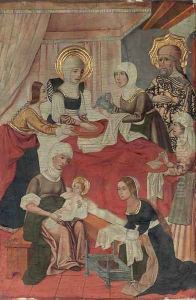Miguel Ximenez Active Saragossa Paintings
Miguel Ximenez was a Spanish painter whose activity is primarily recorded in the late 15th and early 16th centuries, mainly in the city of Saragossa (Zaragoza), in the region of Aragon. Not much is known about his early life or training, but his work is indicative of the Gothic to Renaissance transitional period in Spanish art. Ximenez's contributions are particularly noted for their intricate detail, vibrant coloration, and the incorporation of both Flemish and Italian influences, which was common in Aragonese painting of the time due to the region's political and cultural connections.
His artistic output includes altarpieces and religious panels, which were common commissions during this period. These works often feature biblical and saintly figures rendered with a keen attention to emotion and humanism, a characteristic of the shifting artistic sensibilities of the early Renaissance. One of his most notable works is the altarpiece for the Monastery of Sigena, which showcases his skill in composition and his ability to convey narrative through religious iconography.
Despite the scarcity of detailed records about his life, Miguel Ximenez's surviving works attest to his role in the development of Renaissance art in Spain. His style bridges the medieval traditions with the emerging Renaissance ideals of naturalism and perspective. Unfortunately, like many artists of his time, Ximenez's contributions have been somewhat overshadowed by the later, more famous figures of the Spanish Renaissance. However, his work remains an important part of the study of the period's art history, offering insights into the regional variations of Renaissance art and the transitional phases of European painting.
The exact dates of Ximenez's birth and death are not known, which is not uncommon for artists of this era. Documentation about artists' lives was often sparse, and records that did exist have not always survived. What remains clear, however, is that Miguel Ximenez played a significant role in the artistic landscape of Aragon at the turn of the 16th century, contributing to the spread of Renaissance ideas and aesthetics in Spain.
